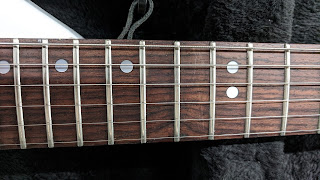The J.B. Player USA Archive Effort
Sunday, October 31, 2021
Details about the Buick
The Buick Prototype is Mine.
The readership of this blog is near zero, I know, and that's okay. I still need some sort of place to consolidate all my thoughts through this hyperfixation of mine. That means I'm going to share some exciting news with all... three of you.
So, I've talked about Bob Mothersbaugh's Buick models being in the possession of author Jade Dellinger. But there was one detail I intentionally left out. Those two were not the only two he had. No... there was one more.
Friday, October 22, 2021
Photos from Associate & Player Eric Lamb
Eric Lamb was mentioned in one of my first blog posts. Since then I've managed to get in contact with him and receive some very rare photos.
The first two are of Eric performing with his band Chops. The third is a promo shot for S-Crew, an underground LA punk group that Eric was also part of. In all of these, he's brandishing a Buick. His words:
"The best thing these guitars had besides their design was the neck on them. Dana tried to copy an original '60s Strat neck when he had those being made.... Mighty Mite did a lot but Dana later started having the guitars assembled overseas and then set up and fine tuned at his factory in Westlake."
I've been told as well that there may be video of S-Crew performing live, with the Buick in action. If that can be found, I'll be first to tell you. Big thanks to Eric Lamb for sharing all these things!
Sunday, October 10, 2021
Some New Views of Jan Kuehnemund's Mercury
I recently found the film Hardbodies on a movie streaming site. I have nothing to really say about the film, because the whole time I was skipping through looking for shots of Vixen performing. This paid off. I have two new pictures of Jan Kuehnemund's Mercury!
Fourth, the controls. On the guitar in the ad there are two knobs, most likely master volume and tone, plus a toggle selector switch. The one in the film has three knobs. I'm inclined to guess that this guitar had a blend control. Dana Zacuto was known for being an experimenter, after all.
This guitar can obviously be seen in other scenes of the movie, but this was where it was most clear. Sadly Jan Kuehnemund is no longer with us to answer questions and I don't even know where I would begin to find people who might know something. If you have a tip, please tell me.
Saturday, June 26, 2021
Steve Bartek of Oingo Boingo's Mercury
What guitarist would be more fitting to represent an all-Californian guitar company than that of California's musical crown jewel? Steve Bartek, primary guitarist and right-hand man of Danny Elfman in Oingo Boingo, utilized his background in jazz and psychedelic rock to weave intricate, multifaceted guitar work into a sonic tapestry that drew from West African highlife, prewar jazz, punk, rockabilly, Balinese gamelan, ska, and synthpop.
Don't worry, you'll get a concrete example in a moment.
Now, a guitarist with eggs in that many baskets ought to have a guitar that can handle something like that, right? Well, throughout his career with the band, Steve was mostly content with a Gibson Les Paul Deluxe, a Carvin DC200, and a Strat with Lace Sensor pickups. But sometime during the Good for Your Soul sessions in late 1982-early 83, J.B. Player approached Steve with a guitar. As recalled by the man himself:
"They made that one for me special (or so they said). I remember it being a little skinny for my fat fingers, but it played well and was way way lighter than my Les Paul, thus easier to play for a long set."
Steve was bandmates with Randy Zacuto in his high school days, so from the get-go a connection was there. He had been in J.B. Player advertisements to begin with as discussed earlier, but a guitar built specifically for him (even if it was just a semi-custom job) was new. This, of course, was his marine blue Mercury, fitted with three singlecoil pickups (most likely Mighty Mite 1100s) and a Kahler 2300 vibrato bridge.
Friday, June 25, 2021
Bob1 of DEVO's Buick
One of the most prevalent guitarists in J.B. Player's early years was Bob "#1" Mothersbaugh of the art punk/new wave group Devo. The spudboys from Akron always had a penchant for playing oddball instruments onstage--from the beginning they brandished department store Hagstroms, Norlin-era Gibsons, and even the exceptionally rare La Baye 2x4.
 |
| Devo circa 1979. L to R: Bob Casale with Gibson L6-S, Bob Mothersbaugh with La Baye 2x4, Gerald Casale with "lobotomized" Gibson Ripper bass. |
Here is the battered, traumatized carcass of the Buick used onstage. Nearly forty concerts' worth of damage are on display in this wreck. The guitar was bashed around so much that the entire control assembly gave out. Tape residue is visible that matches with the above photo.
Thursday, June 24, 2021
Vixen ad circa 1985
Here's a JB Player USA ad from around 1985. This is unfortunately the highest resolution I can find.
Details about the Buick
Now that I have one of these guitars in my hands, let us explore some of the finer points that are relevant to guitar players. First and for...

-
What guitarist would be more fitting to represent an all-Californian guitar company than that of California's musical crown jewel? Stev...
-
Here's a JB Player USA ad from around 1985. This is unfortunately the highest resolution I can find. All of the guitars pictured here a...
-
One of the most prevalent guitarists in J.B. Player's early years was Bob "#1" Mothersbaugh of the art punk/new wave group Dev...






















